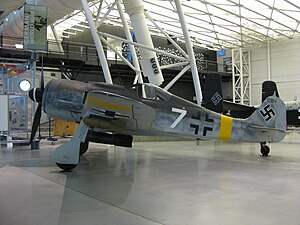| Fighter-bomber attacks on the United Kingdom | |||||||
|---|---|---|---|---|---|---|---|
| Part of World War II | |||||||
 A fighter bomber variant of the Focke-Wulf Fw 190 on display at the Steven F. Udvar-Hazy Center in 2009 | |||||||
| |||||||
| Belligerents | |||||||
|
|
| ||||||
| Casualties and losses | |||||||
| 62 aircraft, 62 pilots[2] | Significant civilian casualties[1] | ||||||
From March 1942 until June 1943, the German Luftwaffe (air force) conducted fighter-bomber attacks on the United Kingdom. These operations typically involved a small number of Focke-Wulf Fw 190 armed with bombs. The raiders entered British airspace at a low altitude, and attacked a town or military target in southern England and then returned to their bases in occupied France. British anti-aircraft batteries and Royal Air Force fighter aircraft had difficulty stopping the German fighter-bombers, and the raids caused a significant number of casualties. While these operations were successful in tying down Allied resources at a relatively low cost to the Luftwaffe, the British Government regarded the campaign as a nuisance given the small scale of the individual raids. The fighter-bomber attacks on the UK ceased in June 1943 when the Fw 190s were transferred to the Mediterranean.